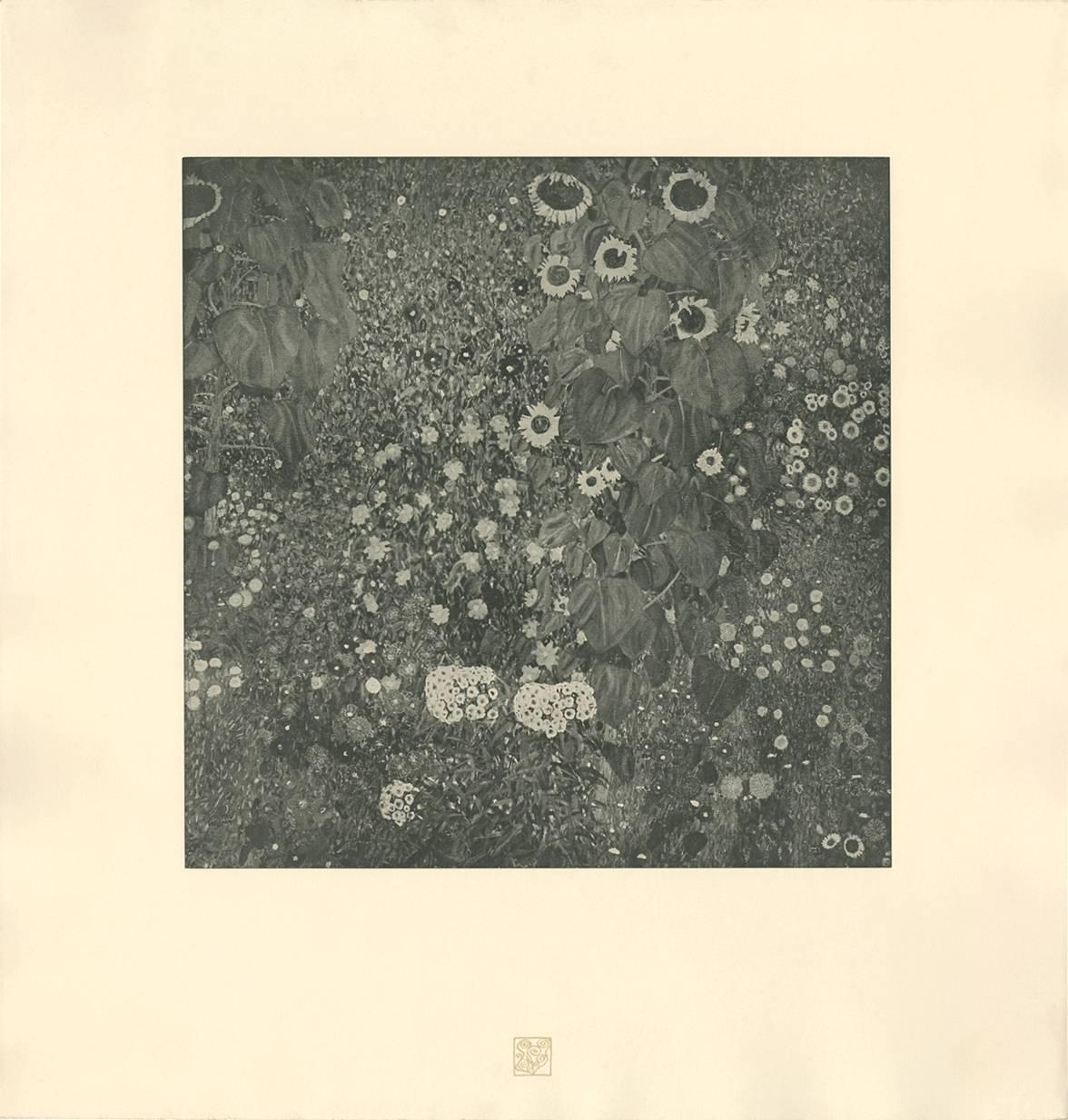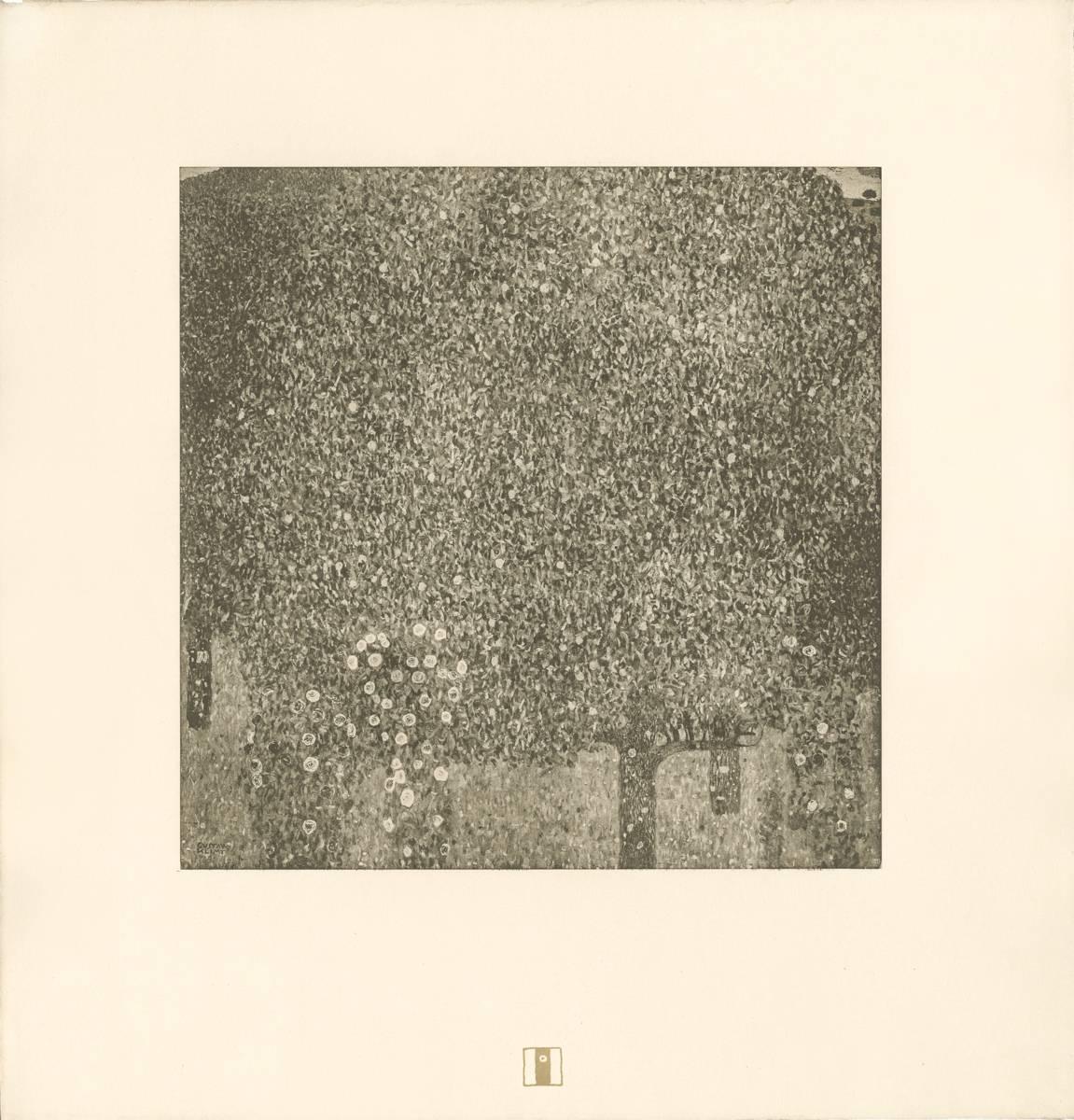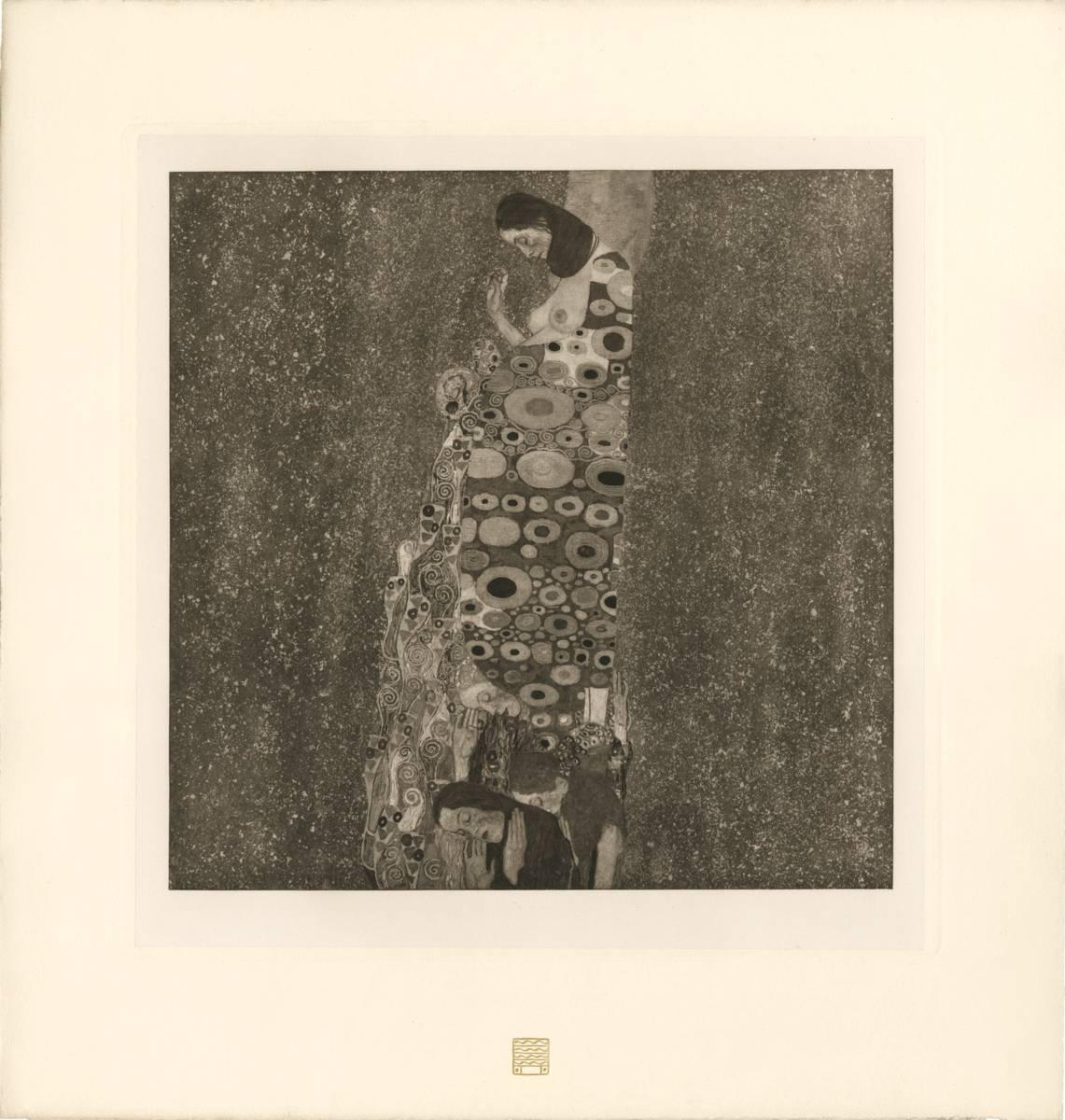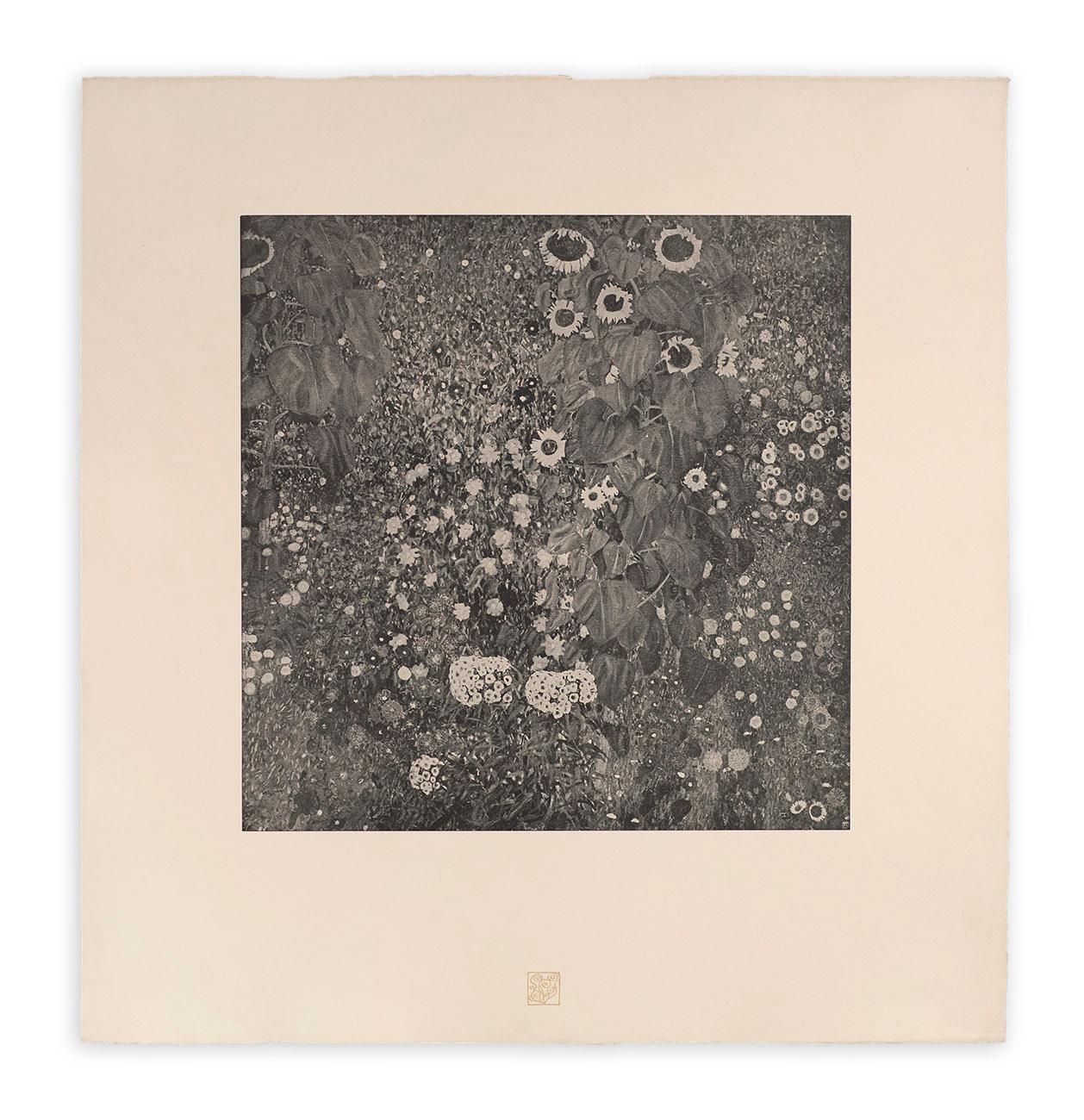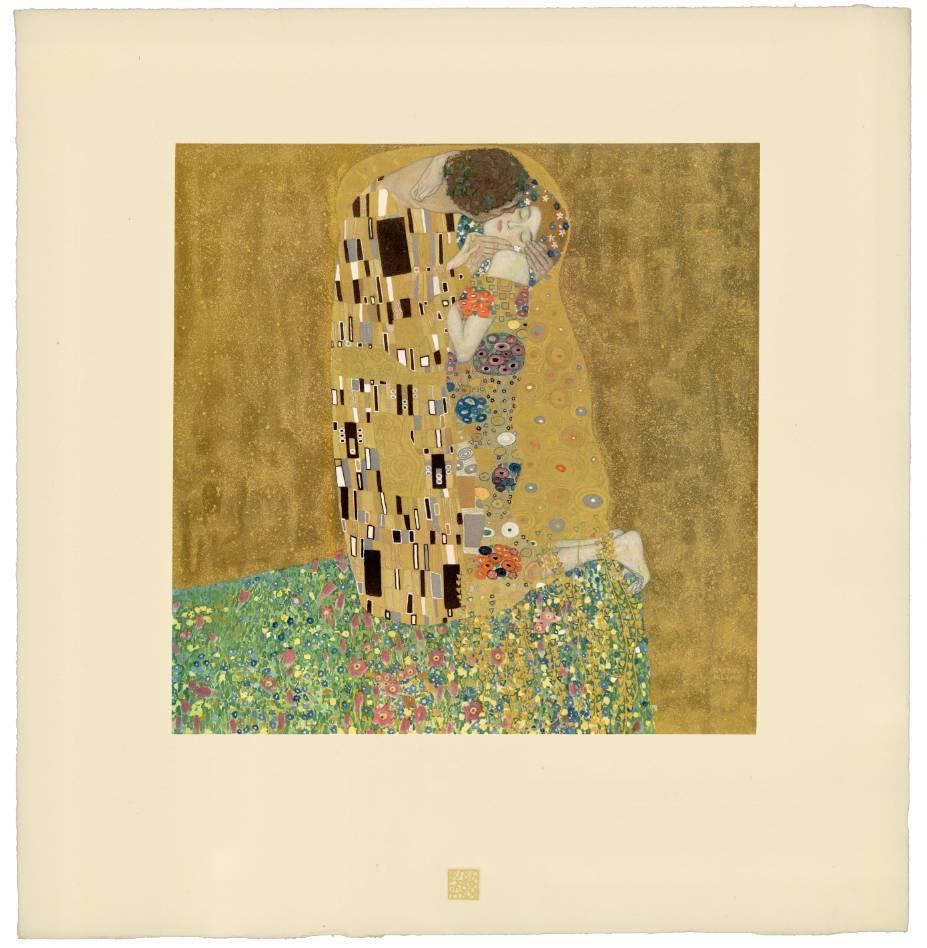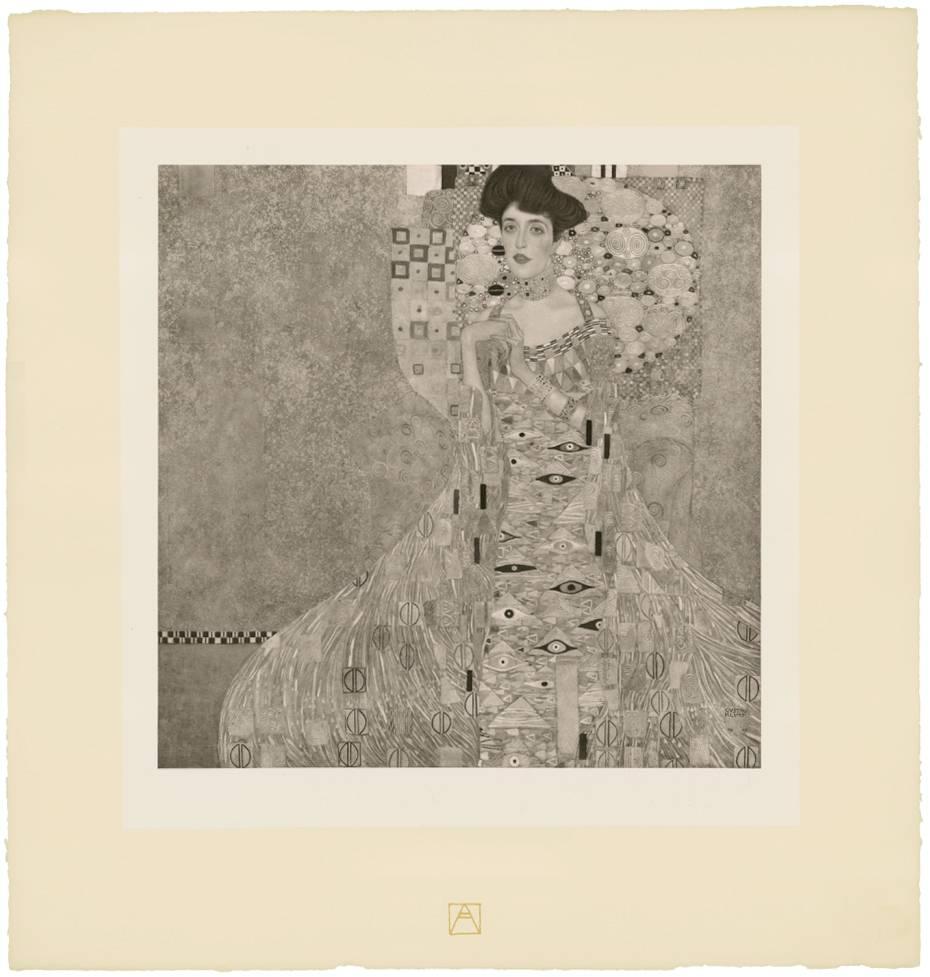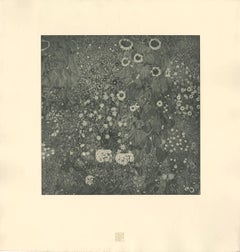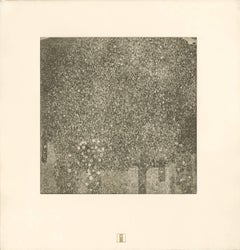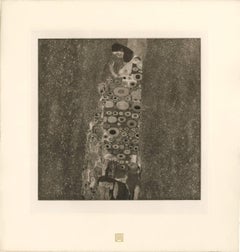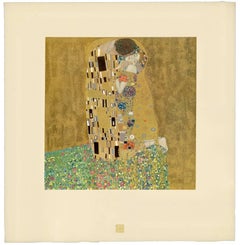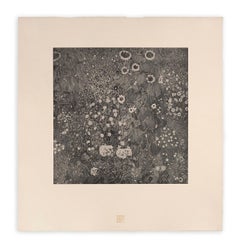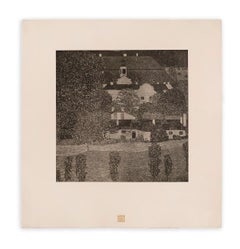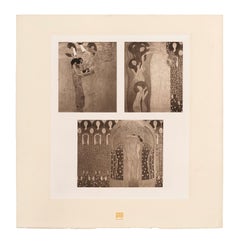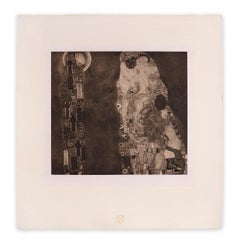Items Similar to H.O. Miethke Das Werk folio "Sunflower" collotype print
Want more images or videos?
Request additional images or videos from the seller
1 of 7
Gustav Klimt & K.K. Hof-und StaatsdruckereiH.O. Miethke Das Werk folio "Sunflower" collotype print1908-1914
1908-1914
$36,000
£27,707.66
€31,554.12
CA$51,179.31
A$55,633.63
CHF 29,156.93
MX$677,108.65
NOK 367,016.03
SEK 344,875.64
DKK 235,646.38
About the Item
Sunflower, no. 10 from the third installment of Das Werk Gustav Klimts
Created during his residency in Litzlberg on Attersee, where Klimt and the Floge family summered from 1900-1907, Klimt explores nature’s transcendental qualities. His single sunflower is human-like, it’s golden halo is like a ring of sun-kissed hair surrounding a bald pate. It’s known that at the same time Klimt was creating this image, he was also at work on a photo essay about the Floge sisters’ clothing from their fashion salon. Their fashion house was best known for its “reform dresses” which featured loose-fitting long robes which billowed at the arms and torso. Viewed with this in mind, it is not a hard leap to imagine the lone sunflower as a self-portrait from reverse. Klimt’s balding head crowned in a golden corona forms the apex of a pyramidal flowing gown of foliage and flowers. By orienting the anthropomorphic flower at the garden’s central foreground and adorning it with repetitive motifs of round flowers of varying sizes, Klimt’s sunflower self-portrait is in harmony with the nature it dominates.
DAS WERK GUSTAV KLIMTS, a portfolio of 50 prints, ten of which are multicolor collotypes on chine colle paper laid down on hand-made heavy cream wove paper with deckled edges; under each of the 50 prints is a gold signet intaglio printed on the cream paper each of which Klimt designed for the publication as unique and relating to its corresponding image; H.O. Miethke, Editor-Publisher; k.k. Hof-und Staatsdruckerei, Printer; printed in a limited edition of 300 numbered plus several presentation copies; Vienna, 1908-1914.
The idea of collaboration in the arts is anything but new; however it has so often been viewed and assessed as somehow devaluing the intrinsic worth of art. It’s as if it was a dirty secret to be hidden away. More so even than the eroticism explored by Klimt, which divided public opinion, the artistic avant-garde began to boldly flaunt artistic collaboration beginning in the 19th century- which gained steam in the first part of the 20th century- to become a driving vehicle of contemporary artistic creation. Viewed in this context, the folios of collotype prints published by H.O. Miethke in Vienna between 1908-1914 known as Das Werk Gustav Klimts, are important art documents worthy of as much consideration for their bold stand they take on established ways of thinking about artistic collaboration as they are for their breathtakingly striking images.
1908 is indeed a watershed moment in the history of art. To coincide with the 60th anniversary of the reign of Emperor Franz Joseph I, Kunstschau opened in Vienna in May of that year. It was there that Klimt delivered the inaugural speech. Speaking about the avant-garde group’s unifying philosophy of Gesamtkunstwerk, or the synthesis of the arts, Klimt shared his belief that the ideal means to bring artists and an audience together was via “work on major art projects.” It was at Kunstschau 1908 that Klimt first exhibited his most iconic painting, The Kiss, as well as The Sunflower, Water Snakes I and II and Danae. It was at Kunstschau 1908 that Das Werk Gustav Klimts was first available for purchase. Thanks to Galerie Miethke’s organization, Kunstschau 1908 was possible. Miethke’s pioneering art house had become Klimt’s exclusive art dealer and main promoter of his modernist vision. Paul Bacher and Carl Moll, a founding member with Klimt of the Vienna Secession, who all broke away during the rift in 1905, took stewardship of the gallery following the fallout with the Secession. Das Werk Gustav Klimts is a prime example of Miethke’s masterful and revolutionary approach to marketing art. Miethke’s innovative marketing strategy played to a penchant for exclusivity. The art gallery and publishing house utilized the press and art critics- such as Austria’s preeminent Art Historian, Hugo Haberfield, who became Director of the gallery in 1912- as a means of gaining publicity as well as maintaining effective public relations. Miethke used the grand exposition format to extend the art gallery’s market reach, cultivating their product’s prestige by stroking the egos of current art patrons while simultaneously creating accessibility for newcomers and others avid collectors to share a relative proximity to other wealthy and respected members of the art collecting community. Essentially, their approach paved the way for what is still the predominant means of marketing.
Between 1908 and 1914, H.O. Miethke published a total of 5 installments of print folios of Klimt’s painted work, each comprising 10 prints. The series was limited in availability to 300 and purchase was arranged through subscription. Each issue was presented unbound in a gold embossed black paper folder. Included in the folio was a Title Page, a Justification page and a Table of Contents page itemizing each of the 10 printed works with details about their corresponding painted works as well as information about each work’s current owner. These folios were not comprehensive of Klimt’s work; but rather, they feature what he believed were his most important paintings from 1898-1913. Only 2 collotypes in each folio were multicolored.
To punctuate the fact that Klimt, himself, was very much an active player in creating these printed works, he created square-shaped signets, unique to each collotype which were intaglio printed in gold ink at the bottom of the cream wove papers to which the chine collie papers were affixed.These signets relate thematically to their corresponding printed images and designate each of those images by their placement in the folio’s Table of Contents page. Functioning much more than simply decorative motifs, these individualized signets provide a distillation of the printed works’s analogous theme. Alice Strobl’s scholarship on this subject confirms Klimt’s involvement throughout the 7-year production process. The Virgin, for example, which dates from c. 1912-1913, was created well after the portfolio was first conceived c. 1908. Its corresponding signet, therefore, could not have been created a priori.
Art Historians, such as Strobl, have shed much light upon the ongoing and collaborative nature of the Das Werk endeavor. Understanding the fragile nature of the collotype printing process also reinforces this project’s distinctive and ground-breaking characteristics. The fragile collotype plates could not be reused. As such, this necessitated the completion of a run on the first go and also dictated the limited production numbers such as the 300 pulled for Klimt’s Das Werk. Printed by hand, the collotypes required deft handling by the printer, k.k..Hof-und Staatsdruckerei. A complicated and lengthy process involving gelatin colloids mixed with dichromates, the creation of 16 color separation thin glass filters to achieve the light-sensitive internegative images which could faithfully capture all of the painting’s tonal gradations and colors, exposure to actinic light, and delicate chine collie papers which allowed for greater color saturation, the printer’s collaborative role in capturing and transmitting Klimt’s nuanced paint strokes is nothing short of remarkable. Ernst Ganglbauer, Director of kaiserlich-konigliche Hof-und Staatsdruckerei (1901-1917) was eager to promote art prints. An innovator, he elevated the Kaiser’s press to international renown by assembling the best of the best in technical and aesthetic advisors. This dream team of free-lance artists developed adaptive uses for the Staatsdruckerei’s existing equipment and, together with the printers there, perfected the multicolor print process for Miethke and Klimt’s Das Werk.
These multicolored collotype prints are perfect examples of what Klimt referred to as “major art projects.” By their very nature, the print medium, these works could bring artists and audience together in a highly accessible way. Each step in the process of their creation required a high level of technical expertise, innovative thinking and true artistic collaboration, Gesamtkunstwerk. The Emperor, himself, was the first to subscribe. His support was firm recognition that Das Werk Gustav Klimts was indeed a masterpiece and product of a dream team enterprise. In the seven-year span that this elite team of talented artists and innovative thinkers produced the complete collection, the Kaiser’s world had radically changed. In just a few years, world war would close with the deaths of Klimt, Miethke, the Austro-Hungarian Empire, marking an end to a fruitful artistic era.
- Creator:Gustav Klimt & K.K. Hof-und Staatsdruckerei (1862 - 1918, Austrian)
- Creation Year:1908-1914
- Dimensions:Height: 18 in (45.72 cm)Width: 18.5 in (46.99 cm)
- Medium:
- Movement & Style:
- Period:
- Condition:
- Gallery Location:Palm Beach, FL
- Reference Number:1stDibs: LU46732050843
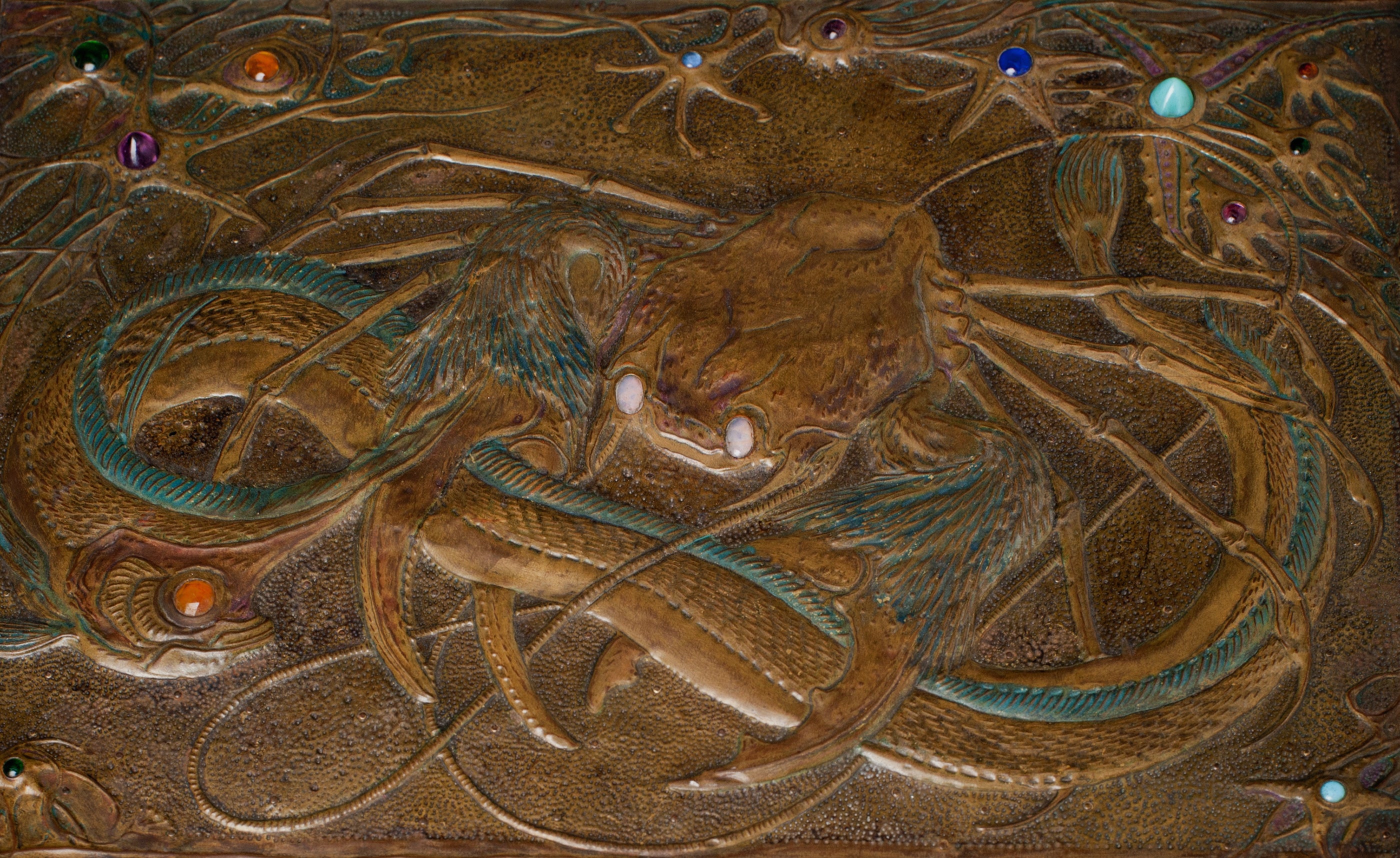
About the Seller
5.0
Gold Seller
Premium sellers maintaining a 4.3+ rating and 24-hour response times
Established in 2013
1stDibs seller since 2016
100 sales on 1stDibs
Typical response time: <1 hour
- ShippingRetrieving quote...Shipping from: Palm Beach, FL
- Return Policy
Authenticity Guarantee
In the unlikely event there’s an issue with an item’s authenticity, contact us within 1 year for a full refund. DetailsMoney-Back Guarantee
If your item is not as described, is damaged in transit, or does not arrive, contact us within 7 days for a full refund. Details24-Hour Cancellation
You have a 24-hour grace period in which to reconsider your purchase, with no questions asked.Vetted Professional Sellers
Our world-class sellers must adhere to strict standards for service and quality, maintaining the integrity of our listings.Price-Match Guarantee
If you find that a seller listed the same item for a lower price elsewhere, we’ll match it.Trusted Global Delivery
Our best-in-class carrier network provides specialized shipping options worldwide, including custom delivery.More From This Seller
View AllH.O. Miethke Das Werk folio "Farm Garden With Sunflowers" collotype print
By Gustav Klimt & K.K. Hof-und Staatsdruckerei
Located in Palm Beach, FL
DAS WERK GUSTAV KLIMTS, a portfolio of 50 prints, ten of which are multicolor collotypes on chine colle paper laid down on hand-made heavy cream wove paper with deckled edges; under ...
Category
Early 1900s Vienna Secession Landscape Prints
Materials
Paper
H.O. Miethke Das Werk folio "Rose" collotype print
By Gustav Klimt & K.K. Hof-und Staatsdruckerei
Located in Palm Beach, FL
DAS WERK GUSTAV KLIMTS, a portfolio of 50 prints, ten of which are multicolor collotypes on chine colle paper laid down on hand-made heavy cream wove paper wi...
Category
Early 1900s Vienna Secession Landscape Prints
Materials
Paper
H.O. Miethke Das Werk folio "The Hope II" collotype print
By Gustav Klimt & K.K. Hof-und Staatsdruckerei
Located in Palm Beach, FL
DAS WERK GUSTAV KLIMTS, a portfolio of 50 prints, ten of which are multicolor collotypes on chine colle paper laid down on hand-made heavy cream wove paper with deckled edges; under ...
Category
Early 1900s Vienna Secession Figurative Prints
Materials
Paper
H.O. Miethke Das Werk folio "The Kiss" collotype print
By Gustav Klimt & K.K. Hof-und Staatsdruckerei
Located in Palm Beach, FL
The Kiss, no. 1 from the fifth installment of Das Werk Gustav Klimts
Undoubtedly Klimt’s best known and most reproduced images, this printed version of The Kiss is the only one with which Klimt was directly involved. Unveiled at Vienna’s Kunstschau 1908, and saved for the fifth and final delivery of Das Werk, The Kiss marks a triumph in Klimt’s career and represents a culmination of many themes in his oeuvre up to that point. After all of the controversy surrounding the State’s prior rejection of the University murals commissioned from Klimt, the Ministry of Education reversed their policy toward the artist with a show of wholehearted support by purchasing for the Osterreichische Galerie BelvedereThe Kiss while it still hung in the Kunstschau exhibit.
Considered in relation to the eight multicolored collotypes which preceded its print debut in the Das Werk portfolio, The Kiss literally embraces all which came before it. The golden seaweed dangling in tresses from the lovers’ feet harkens back to Water Snakes I and II. The bed of flowers evokes the settings Klimt created in both The Golden Knight and The Sunflower. In fact, this image sprung out of a particularly happy summer spent in the company of Klimt’s lover, Emilie Floge...
Category
Early 1900s Vienna Secession Figurative Prints
Materials
Handmade Paper
H.O. Miethke Das Werk folio "Portrait of Adele Bloch-Bauer" collotype print
By Gustav Klimt & K.K. Hof-und Staatsdruckerei
Located in Palm Beach, FL
This listing is for a single print, pictured, from the Das Werk portfolio by Gustav Klimt and k.k. Hof-und Staatsdruckerei, published by H.O. Miethke. Gu...
Category
Early 1900s Vienna Secession Figurative Prints
Materials
Paper
H.O. Miethke Das Werk folio "Portrait of Hermine Gallia" collotype print
By Gustav Klimt & K.K. Hof-und Staatsdruckerei
Located in Palm Beach, FL
DAS WERK GUSTAV KLIMTS, a portfolio of 50 prints, ten of which are multicolor collotypes on chine colle paper laid down on hand-made heavy cream wove paper with deckled edges; under ...
Category
1910s Vienna Secession Figurative Prints
Materials
Paper
You May Also Like
Farm Garden Sunflowers by Gustav Klimt, Das Werk lifetime collotype, 1908-1912
By Gustav Klimt
Located in Chicago, IL
Original collotype created from Gustav Klimt’s Farm Garden With Sunflowers, painted in 1913. Published and edited by Verlag H.O. Miethke and printed by k.k. Hof- und Staatsdruckerei, Vienna, in an edition of 300.
Between 1908 and 1914, H.O. Miethke published Das Werk Gustav Klimts...
Category
Early 1900s Vienna Secession Prints and Multiples
Materials
Paper
Schloss Kammer Lake Attersee II by Gustav Klimt, Das Werk collotype, 1908-1912
By Gustav Klimt
Located in Chicago, IL
Original collotype created from Gustav Klimt’s Schloss Kammer on Lake Attersee II (Das Werk Gustav Klimts), originally painted in 1909. Publishe...
Category
Early 1900s Vienna Secession Prints and Multiples
Materials
Paper
Beethoven Frieze (detail) by Gustav Klimt, Das Werk collotype, 1908-1912
By Gustav Klimt
Located in Chicago, IL
Original collotype created from a detail of Gustav Klimt’s Beethoven Frieze. Published and edited by Verlag H.O. Miethke and printed by k.k. Hof- und Staatsdruckerei, Vienna, in an e...
Category
Early 1900s Vienna Secession Prints and Multiples
Materials
Paper
Death and Life by Gustav Klimt, Das Werk lifetime collotype, 1908-1912
By Gustav Klimt
Located in Chicago, IL
Original collotype created from Gustav Klimt’s Death and Life, painted in 1908. Published and edited by Verlag H.O. Miethke and printed by k.k. Hof- und St...
Category
Early 1900s Vienna Secession Prints and Multiples
Materials
Paper
Expectation-Metallic Poster. Printed in Austria
By Gustav Klimt
Located in Chesterfield, MI
Poster. Measures 16 x 11 inches and is Unframed. Good/Fair Condition-signs of wear consistent with age and handling.
Category
Late 20th Century Portrait Prints
Materials
Lithograph
$140 Sale Price
20% Off
Fruit Trees by Gustav Klimt, Das Werk lifetime landscape collotype, 1908-1912
By Gustav Klimt
Located in Chicago, IL
Original collotype created from Gustav Klimt’s Impressionist Fruit Trees landscape, painted in 1901. Published and edited by Verlag H.O. Miethke and printed by k.k. Hof- und Staatsdruckerei, Vienna, in an edition of 300.
Between 1908 and 1914, H.O. Miethke published Das Werk Gustav Klimts...
Category
Early 1900s Vienna Secession Prints and Multiples
Materials
Paper
More Ways To Browse
Antique Paper Embosser
Flowing Gowns
19th Century Reverse Painting On Glass
Sun Ring
Kiss Ring
Peter Lind
Peter Max Kentucky Derby
Peter Max Mini
Pink Vintage Bathtub
Rick Dula On Sale
Robert Longo Wave
Ron Lawson
Rosamond Tudor On Sale
Rowena Fry
Roy Lichtenstein Sunrise
Salvador Dali The Alps
Salvador Dali Venice
Stephen McMillan On Sale
